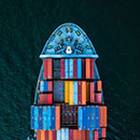
Ocean freight rates appear to be staying relatively firm, despite falling demand, as lines exhibit “a high degree of capacity management discipline during the Coronavirus pandemic”.
The ‘composite index’ – the combined average freight rates on the major east-west container trades – according to the World Container index (WCI) assessed by Drewry, decreased 1.7% last week to an average of $1,504 per 40ft container, but is 13.1% up when compared with same period of 2019.
Freight rates on New York–Rotterdam waned 8% or $44 to touch $504 per feu, while rates from Shanghai to Los Angeles declined 6% to reach $1,605 per 40ft box – although this was 7% above the level of previous year. Similarly, spot rates from Rotterdam to Shanghai dropped 5% to $974 for a 40ft box, but 79% up from the same period of 2019.
Conversely, Shanghai to Rotterdam rates climbed 3% and stood at $1,475 per 40ft container – up 12%, year on year. Also, Shanghai to Genoa prices were up 1%, week on week, and up 25% compared with last year.
Drewry expects rates “to remain challenged in the coming week”.
Meanwhile, container shipping analysts Sea-Intelligence’s latest Sunday Spotlight briefing “shows how the carriers are exhibiting a high degree of capacity management discipline during the Coronavirus pandemic”.
Alan Murphy, CEO of Sea-Intelligence, commented: “We are now at a point where 435 sailings are now cancelled on various deep-sea trades, and this in itself indicates a demand decline of 7 Million TEU in 2020.
“This forceful response to the market downturn has thus far served as a strong underpinning for the freight rates though. Seen over the past 6 weeks, the CCFI contract rate index is 11% higher than at the same period last year – despite the drop in both demand and oil prices. The decline in the overall index since Chinese New Year can be shown to be in line with normal seasonality.”
However, he said it can also be seen that the approach to the blank sailings differs between alliances, noting: “The pattern is that 2M and THE Alliance have chosen an approach where they announce blank sailings ranging quite far into the future – typically to the end of Q2 – and then supplement these with a few additional blank sailings tactically as the situation evolves.
“Ocean Alliance on the other hand announce blank sailings for a shorter period into the future and have not yet announced much for the later period in Q2. As an example on the transpacific, the three alliances have each blanked some 17-24% in weeks 15-21. However, for weeks 22-27, 2M and THE Alliance have blanked 19-21% whereas Ocean Alliance at this point has blanked only 6%.”
He noted: “Given how the pandemic is impacting the economy it should be expected that we will see more blank sailings emerge from Ocean Alliance in Q2.”
Source: lloydsloadinglist
The opinions expressed herein are the author's and not necessarily those of The OLO News.
Quality Companies